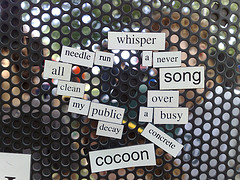Via @brkeogh – Craft and Form by Andrew Vanden Bossche is well worth reading.
Talking about character and plot without form rapidly becomes ungrounded and airy, because I’m hearing about people that aren’t real and things that didn’t happen without any grounding in the countless craft and form choices that made all of that junk matter. If plot and character was all that mattered, Wikipedia would be a sufficient replacement for literature. Any description of the effect a game has on the author should come with your explanation of how that happened. What exactly was it about the heartbreaking indie puzzle platformer that made you feel nostalgic? What did Jane Austin do to make you like that dour Mr. Darcy so much? These are not strange or unusual or “academic” questions, they are questions of very basic specificity and clarity in any sort of writing. It’s incomplete to talk about the emotional reaction the game effected in you without describing the cause. This matters for “game mechanics” but it applies equally to writing, art, and music, and the mechanics and form and craft that drive those as well
Where I part ways with him is that I don’t think it’s critics’ backgrounds in literature or English that are an issue here, so much as it’s the particular critical skills that are being brought to bear on games. At present a great deal of games writing is concerned with hermeneutic questions – issues of interpretation. What does it mean? What is it trying to say, or saying without trying? Is it aesthetically pleasing? What’s the cultural or generic context? But much less common, as Andrew notes, are questions of poetics: questions that tackle the mechanics of how a game functions, how its elements fit together and act upon the player – or how the player acts upon them – to cause an effect.
Robert Louis Stevenson speaks to game designers about realism as a tool, as well as to writers. Rise of the Videogame Zinesters has kinship with the Personism Manifesto in its approach to accessibility, personality, realities of experience. It’s only a matter of time before we get a video game version of Projective Verse, most likely delivered at a conference or in free ebook form disguised as a design approach to the Oculus Rift. I can see Aristotle getting along nicely with video game formalism.
This leads me to suspect that – concerned as they are with the mechanics of language, the careful structuring of words to build worlds with minimal tools, with rhythm, pace, meter, tone, pattern, breath, the physiology of the reader, the interweaving of meaning with mechanic – theories of video games are going to end up having a surprising amount in common with theories of poetry. I know that my own thinking about game mechanics – in terms of their effects and their overall aims – draws on poetics as a framework along with other disciplines. But they’re often excruciatingly inaccessible, and perhaps lifting the curtain is less engaging for audiences who want to be entertained, rather than to examine the nuts and bolts. As Stevenson says:
There is nothing more disenchanting to man than to be shown the springs and mechanism of any art. All our arts and occupations lie wholly on the surface; it is on the surface that we perceive their beauty, fitness, and significance; and to pry below is to be appalled by their emptiness and shocked by the coarseness of the strings and pulleys. … We shall never learn the affinities of beauty, for they lie too deep in nature and too far back in the mysterious history of man. The amateur, in consequence, will always grudgingly receive details of method, which can be stated but never can wholly be explained…
